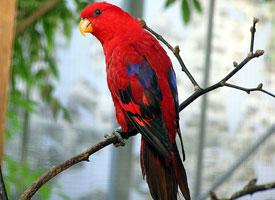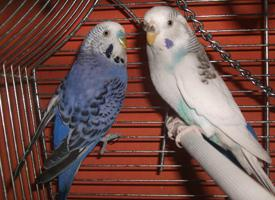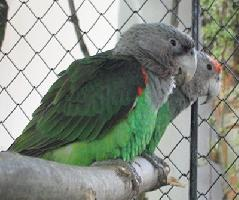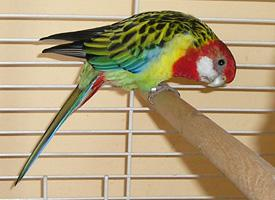
Greutăți și măsuri
| Lungime | 31 cm |
|---|
Descrierea animalului
The Red lory (Eos bornea), a vibrant and charismatic species, is a small to medium-sized parrot native to the Maluku Islands in Indonesia. With its striking red plumage, this bird is a captivating sight, embodying a fiery palette that ranges from deep crimson to bright scarlet across its body. The intensity of its coloration is not just limited to its feathers; even its beak and the skin around its eyes exhibit a similar bold red, making it one of the most visually striking members of the parrot family.Measuring approximately 26 to 31 centimeters in length and weighing around 120 to 160 grams, the Red lory has a robust and somewhat rounded body shape typical of lories and lorikeets. Its wings are relatively short and rounded, while its tail is somewhat elongated and tapered, aiding in its agile flight through the dense rainforest canopies it calls home.
One of the most distinctive features of the Red lory, aside from its vivid coloration, is its brush-tipped tongue. This specialized tongue is an adaptation for its primary diet of nectar, pollen, and fruit. The brush-like tips allow the bird to effectively gather nectar from flowers, making it an important pollinator within its ecosystem. Despite this specialization, the Red lory is also known to consume small insects and other sources of protein, showcasing its opportunistic feeding behavior.
Behaviorally, the Red lory is known for its social and playful nature. These birds are often seen in pairs or small flocks, engaging in intricate aerial displays, mutual preening, and vocal communications that include a range of whistles, squawks, and chirps. Their social structure and bonding rituals highlight their complex social interactions, which are a delight to observe both in the wild and in captivity.
The habitat of the Red lory is predominantly in the tropical rainforests and coastal mangroves of the Maluku Islands. They are highly adaptable, however, and can also be found in secondary forests and cultivated areas where they sometimes are considered pests due to their attraction to agricultural crops, particularly fruit trees.
Conservation status of the Red lory has been a concern, as habitat loss and the pet trade have negatively impacted their populations. Although they are currently listed as Least Concern by the International Union for Conservation of Nature (IUCN), ongoing efforts to monitor and protect their natural habitats are crucial to ensuring their survival.
In captivity, the Red lory can be a challenging but rewarding pet. Their intelligence, playful demeanor, and ability to form strong bonds with their human caretakers make them appealing companions. However, they require a specialized diet, plenty of space for exercise, and social interaction to thrive, underscoring the commitment needed to care for such a dynamic and vibrant bird.
In summary, the Red lory (Eos bornea) is a stunningly beautiful and fascinating bird species, embodying the vibrant biodiversity of the Indonesian archipelago. Its striking appearance, complex behaviors, and ecological roles in pollination highlight the importance of conserving the natural wonders of our planet.
Animale similare
Fotografii noi cu animale
Top 10 animale
- Dolphin gull (Leucophaeus scoresbii)
- Diana monkey (Cercopithecus diana)
- Moustached guenon (Cercopithecus cephus)
- Stone loach (Barbatula barbatula)
- Greek tortoise (Testudo graeca)
- Galápagos tortoise (Geochelone nigra complex)
- Japanese macaque (Macaca fuscata)
- Russian tortoise (Testudo horsfieldii)
- Common flying dragon (Draco volans)
- Galápagos penguin (Spheniscus mendiculus)


